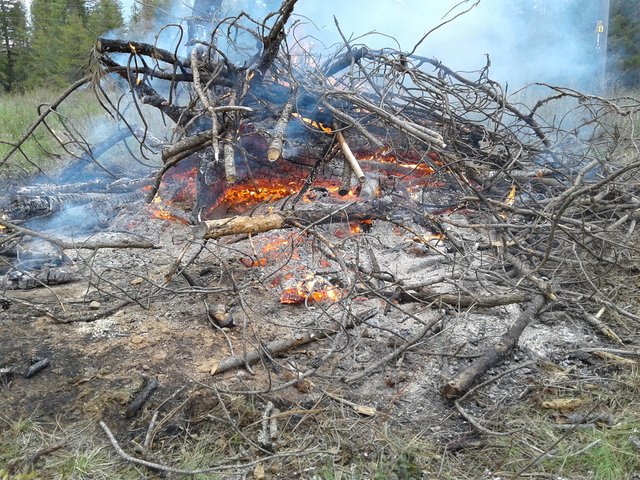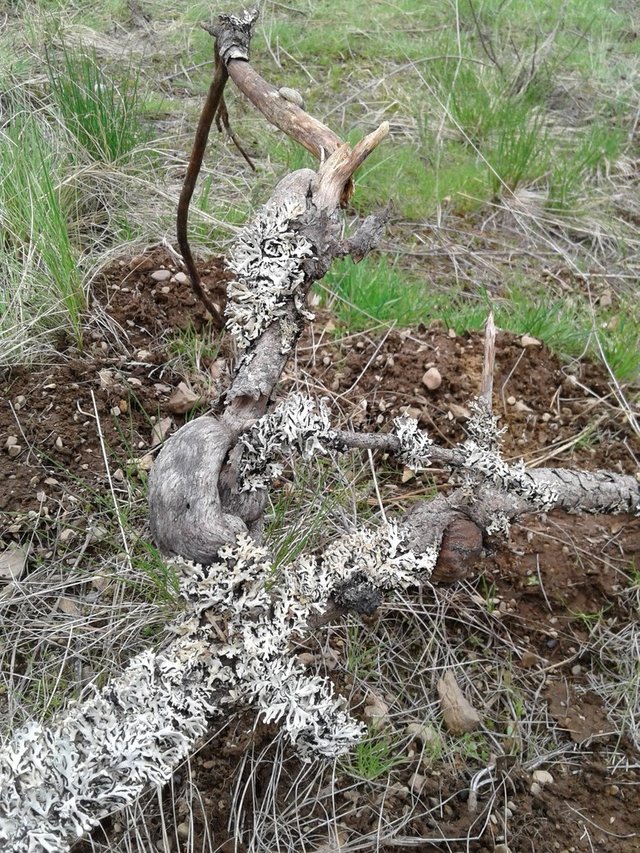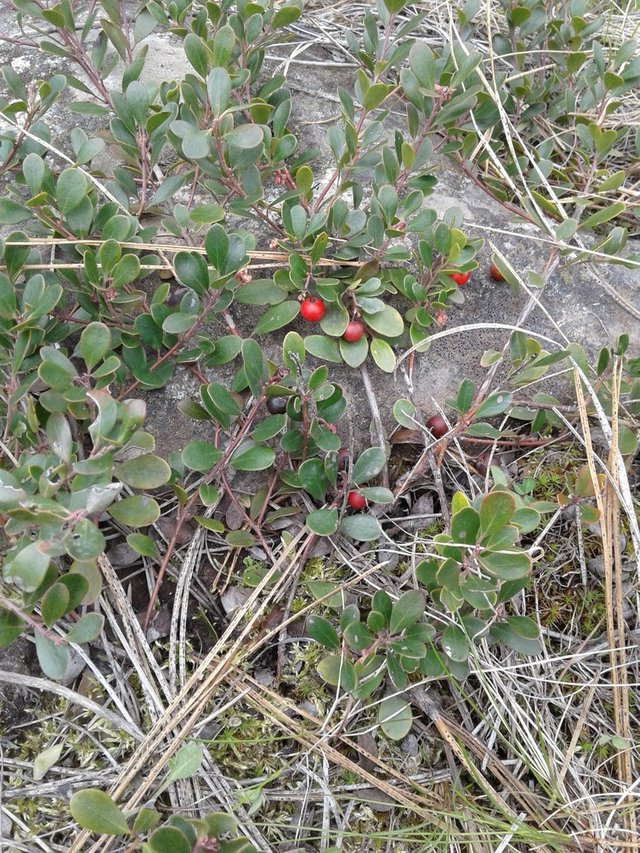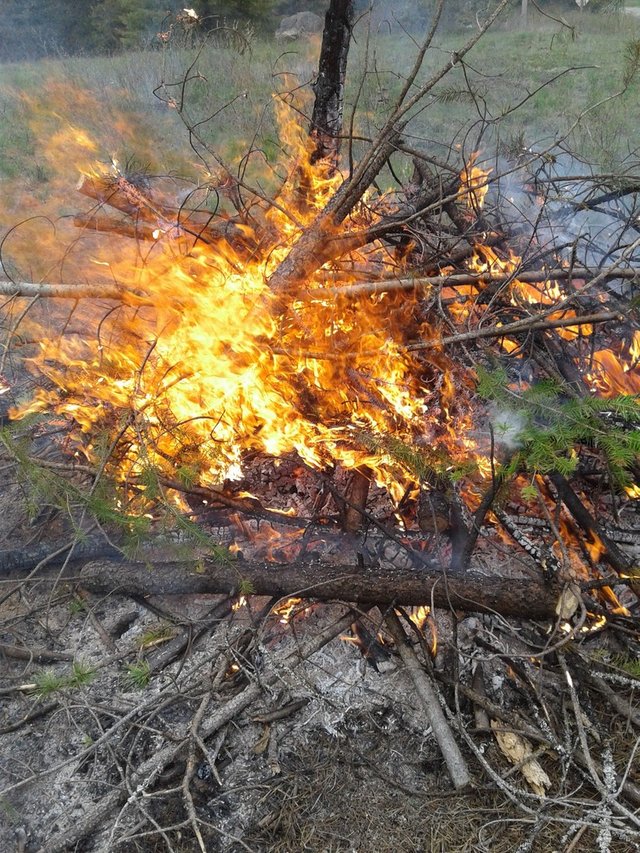Forest Cleanup
My parents live on a plot of land that is now heavily forested despite some painfully aggressive logging that occurred before they bought it. It is now an ongoing chore to thin the trees that have sprouted since then, and some areas have been neglected. I spent about an hour helping my dad burn the brush left over from cleaning up one such part of the property.

Fire in progress
Several large stumps were left over from utility work that required clearing some larger trees, so those were the foundation material for this fire. Saplings, dead branches, and diseased trees were added to the blaze. There is no danger of fire spreading due to building it in this cleared space, and it has been a wet winter/spring. Extra water was on hand anyway.
Since the time the property was logged, many small trees have grown up, but some have been severely afflicted with pine gall rust, a fungal infection that creates blobby growths on trunks and branches, and can kill or cripple the young trees.

Dead branch with lichens and galls
By thinning the trees, culling those with severe disease, and trimming the lower branches on older trees that remain, we hope to revitalize the forest and allow healthy growth for what remains. This will also reduce fire hazard, because many lower branches on these trees are dead already. Instead we want lush, green, healthy undergrowth along with strong, healthy trees.

I don't know what this is, but more of it would probably be good...
Once the fire is done, the burnt patch of earth with its layer of ashes will also create a small haven for new growth as other such burn piles have over the years, enriching the otherwise-poor soil here. Meanwhile, FIRE!

Edit
He read this, and asked me to specify that he spent considerably more than an hour on the project himself, and clarify the limited nature of my assistance to those unfamiliar with how laborious such cleanup work is.

In Australia some gum trees rely on fire to clear the under growth, split the seed case, allowing the seed to grow. Fire was also used to clear the bush and fern on NZs now farm lands, they were then sown with grass seed for the paddocks. Do a Papa-pepper and dig up any interesting small trees and replant them in the right spot avfter the fire
Nah, I want to let the wild plants grow wild in their native wild habitat. There are invasive weeds here that thrive on poor soil, and move in first if anything is disturbed unless something like the fire ring gives the native plants a nutritional advantage. Spotted knapweed is especially problematic here. Part of the reason behind clearing the underbrush and pruning limbs is to give a boost to native plants.
Try flame weeding, they are available in USA and are one hand operatable, run off LPG, easy to fire up, walk over the area and squirt the weeds you want killed, it is a long term job as it only kills the top bit without a top nothing will grow so success is obtainable. Ask an agriculture machine shop in your area, or Uncle Google, he knows everything.
BAD idea here. When the knapweed is ready to be taken down before going to seed, everything else is far too dry to be playing with fire. And it's far too widespread for spot treatment.
don't wait for it to grow, when it first pokes it's head through the ground, hit it.
As an experiment, pick a small patch, boil some water, sprinkle it over the test bed and repeat weekly. At the end of the year see how the weeds are.
A pain in the *** but it is a test, over time, a long time, you should clear the whole area.
It works in NZ, on our painful weeds.
I don't want to denigrate your well-intentioned advice, but I don't think you understand how widespread this stuff is. For perspective, I will try to remember to post pictures this July to show what I mean. It's everywhere. It's almost as abundant as grass in the fields. If you know what you're looking for, you can see its dried dead remnants from last year everywhere in this post.
The real long-term solution is improving the growing conditions here so native plants have a better chance to out-compete the stuff. Knapweed likes poor soil and weak competition. We are improving the opportunities for its native competition. In the short term, mowing is a somewhat-beneficial practice.
it's a lot of work clearing and preparing land. It's gonna look great once it's done. Good work. ^^
This post has been ranked within the top 50 most undervalued posts in the first half of Apr 30. We estimate that this post is undervalued by $2.00 as compared to a scenario in which every voter had an equal say.
See the full rankings and details in The Daily Tribune: Apr 30 - Part I. You can also read about some of our methodology, data analysis and technical details in our initial post.
If you are the author and would prefer not to receive these comments, simply reply "Stop" to this comment.
I've been clearing an overgrown spot in my backyard that used to be a firepit area. Got the final patch done a couple days ago and was able to actually USE the firepit. It's been at least 3 years. Sigh.
Good job on the clean up! It's a a lot a hard work, but lighting and feeding that fire feels GREAT!